alternator Peugeot 3008 Hybrid 4 2014 Owner's Manual
[x] Cancel search | Manufacturer: PEUGEOT, Model Year: 2014, Model line: 3008 Hybrid 4, Model: Peugeot 3008 Hybrid 4 2014Pages: 378, PDF Size: 22.5 MB
Page 6 of 378
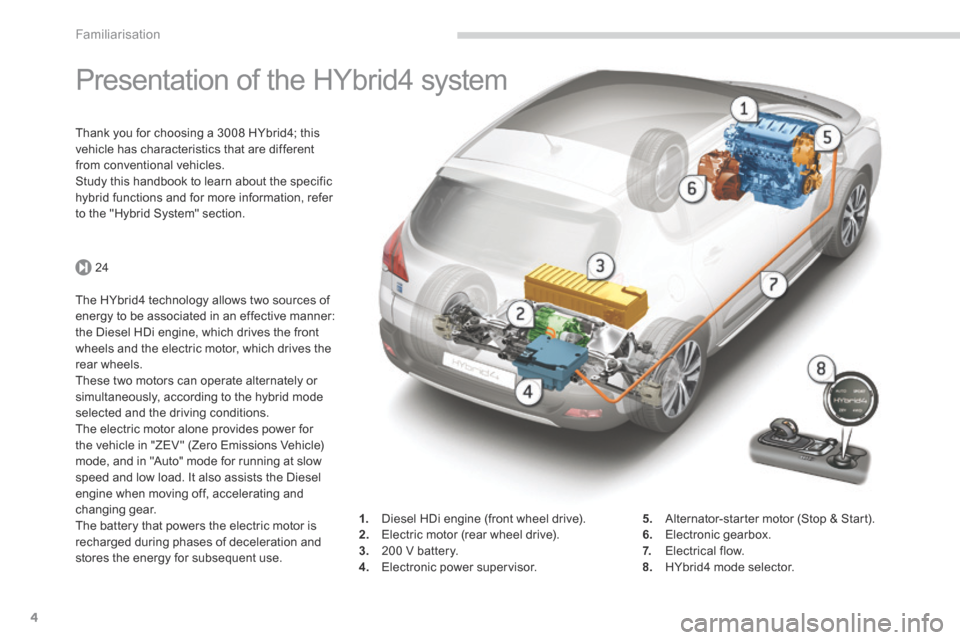
24
Familiarisation
4
Presentation of the HYbrid4 system
Thank you for choosing a 3008 HYbrid4; this vehicle has characteristics that are different from conventional vehicles. Study this handbook to learn about the specific hybrid functions and for more information, refer to the "Hybrid System" section.
The HYbrid4 technology allows two sources of energy to be associated in an effective manner: the Diesel HDi engine, which drives the front wheels and the electric motor, which drives the rear wheels. These two motors can operate alternately or simultaneously, according to the hybrid mode selected and the driving conditions. The electric motor alone provides power for
the vehicle in "ZEV " (Zero Emissions Vehicle) mode, and in "Auto" mode for running at slow speed and low load. It also assists the Diesel engine when moving off, accelerating and changing gear. The battery that powers the electric motor is recharged during phases of deceleration and stores the energy for subsequent use.
1. Diesel HDi engine (front wheel drive).
2. Electric motor (rear wheel drive). 3. 200 V battery. 4. Electronic power supervisor.
5. Alternator-starter motor (Stop & Start).
6. Electronic gearbox. 7. Electrical flow. 8. HYbrid4 mode selector.
Page 26 of 378
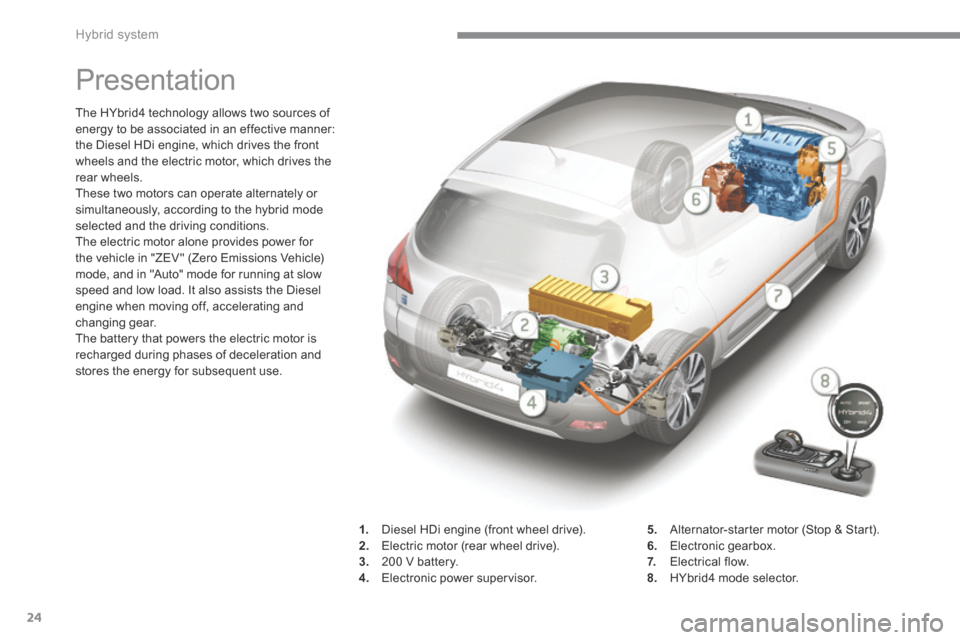
Hybrid system
24
Presentation
The HYbrid4 technology allows two sources of energy to be associated in an effective manner: the Diesel HDi engine, which drives the front wheels and the electric motor, which drives the rear wheels. These two motors can operate alternately or simultaneously, according to the hybrid mode selected and the driving conditions. The electric motor alone provides power for the vehicle in "ZEV " (Zero Emissions Vehicle) mode, and in "Auto" mode for running at slow speed and low load. It also assists the Diesel engine when moving off, accelerating and changing gear. The battery that powers the electric motor is recharged during phases of deceleration and stores the energy for subsequent use.
1. Diesel HDi engine (front wheel drive). 2. Electric motor (rear wheel drive). 3. 200 V battery. 4. Electronic power supervisor.
5. Alternator-starter motor (Stop & Start). 6. Electronic gearbox. 7. Electrical flow. 8. HYbrid4 mode selector.
Page 27 of 378
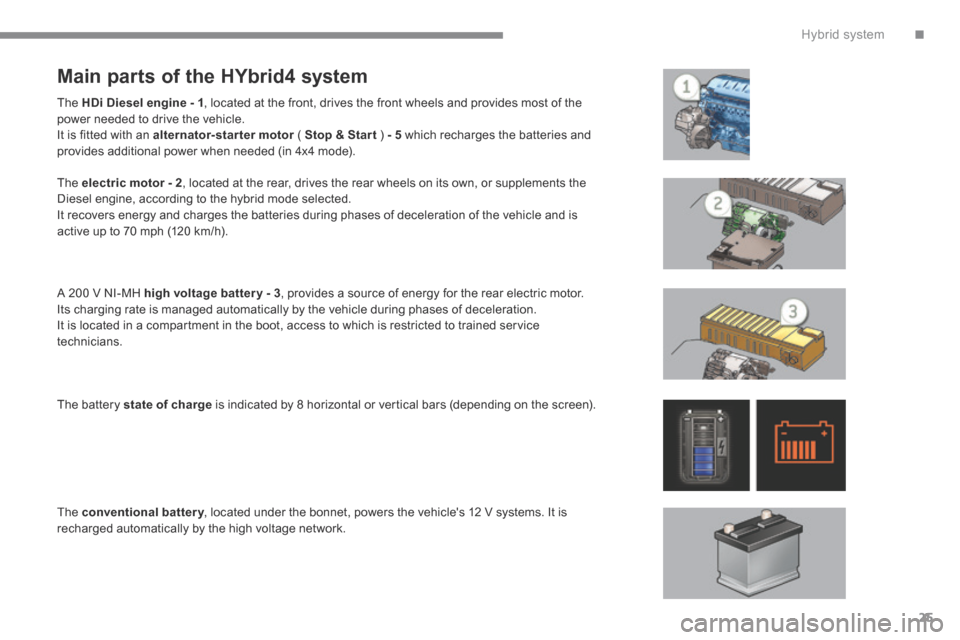
.Hybrid system25
Main parts of the HYbrid4 system
The HDi Diesel engine - 1 , located at the front, drives the front wheels and provides most of the power needed to drive the vehicle. It is fitted with an alternator-starter motor ( alternator-starter motor ( alternator-starter motorStop & Star t ) - 5 which recharges the batteries and provides additional power when needed (in 4x4 mode).
The electric motor - 2 , located at the rear, drives the rear wheels on its own, or supplements the Diesel engine, according to the hybrid mode selected. It recovers energy and charges the batteries during phases of deceleration of the vehicle and is
active up to 70 mph (120 km/h).
A 200 V NI-MH high voltage batter y - 3 , provides a source of energy for the rear electric motor. Its charging rate is managed automatically by the vehicle during phases of deceleration. It is located in a compartment in the boot, access to which is restricted to trained service technicians.
The battery state of charge is indicated by 8 horizontal or vertical bars (depending on the screen).
The conventional battery , located under the bonnet, powers the vehicle's 12 V systems. It is conventional battery , located under the bonnet, powers the vehicle's 12 V systems. It is conventional batteryrecharged automatically by the high voltage network.
Page 28 of 378
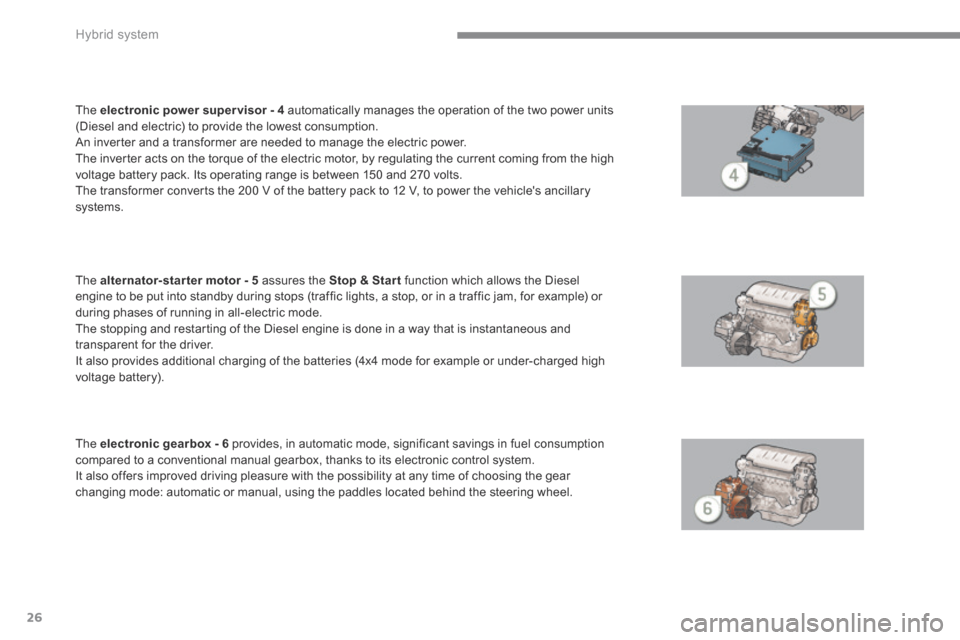
Hybrid system
26
The electronic power super visor - 4 automatically manages the operation of the two power units (Diesel and electric) to provide the lowest consumption. An inverter and a transformer are needed to manage the electric power. The inverter acts on the torque of the electric motor, by regulating the current coming from the high voltage battery pack. Its operating range is between 150 and 270 volts. The transformer converts the 200 V of the battery pack to 12 V, to power the vehicle's ancillary systems.
The alternator-starter motor - 5 assures the Stop & Star t function which allows the Diesel engine to be put into standby during stops (traffic lights, a stop, or in a traffic jam, for example) or during phases of running in all-electric mode. The stopping and restarting of the Diesel engine is done in a way that is instantaneous and transparent for the driver. It also provides additional charging of the batteries (4x4 mode for example or under-charged high voltage battery).
The electronic gearbox - 6 provides, in automatic mode, significant savings in fuel consumption compared to a conventional manual gearbox, thanks to its electronic control system. It also offers improved driving pleasure with the possibility at any time of choosing the gear changing mode: automatic or manual, using the paddles located behind the steering wheel.
Page 33 of 378
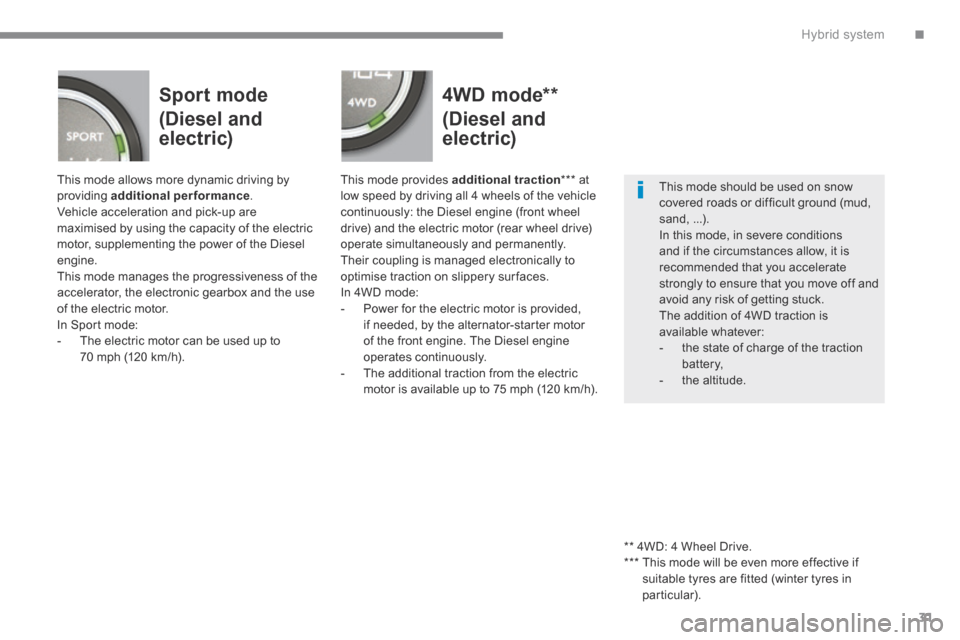
.Hybrid system31
Sport mode
(Diesel and
electric)
4WD mode **
(Diesel and
electric)
This mode allows more dynamic driving by providing additional performance . Vehicle acceleration and pick-up are maximised by using the capacity of the electric motor, supplementing the power of the Diesel engine. This mode manages the progressiveness of the accelerator, the electronic gearbox and the use of the electric motor. In Sport mode: - The electric motor can be used up to 70 mph (120 km/h).
This mode provides additional traction *** at low speed by driving all 4 wheels of the vehicle continuously: the Diesel engine (front wheel drive) and the electric motor (rear wheel drive) operate simultaneously and permanently. Their coupling is managed electronically to optimise traction on slippery sur faces. In 4WD mode: - Power for the electric motor is provided, if needed, by the alternator-starter motor of the front engine. The Diesel engine operates continuously. - The additional traction from the electric motor is available up to 75 mph (120 km/h).
** 4WD: 4 Wheel Drive. *** This mode will be even more effective if suitable tyres are fitted (winter tyres in particular).
This mode should be used on snow covered roads or difficult ground (mud, sand, ...).
In this mode, in severe conditions and if the circumstances allow, it is recommended that you accelerate strongly to ensure that you move off and avoid any risk of getting stuck. The addition of 4WD traction is available whatever: - the state of charge of the traction battery, - the altitude.
Page 45 of 378
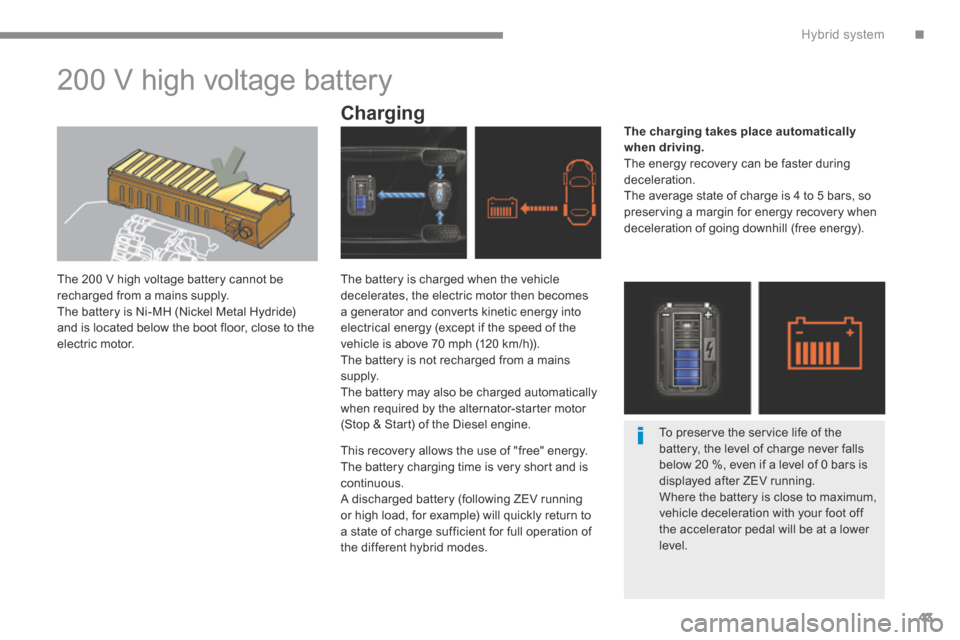
.Hybrid system43
200 V high voltage battery
The 200 V high voltage battery cannot be recharged from a mains supply. The battery is Ni-MH (Nickel Metal Hydride) and is located below the boot floor, close to the electric motor.
Charging The charging takes place automatically when driving . The energy recovery can be faster during deceleration. The average state of charge is 4 to 5 bars, so preserving a margin for energy recovery when deceleration of going downhill (free energy).
The battery is charged when the vehicle decelerates, the electric motor then becomes a generator and converts kinetic energy into electrical energy (except if the speed of the vehicle is above 70 mph (120 km/h)). The battery is not recharged from a mains supply. The battery may also be charged automatically when required by the alternator-starter motor (Stop & Start) of the Diesel engine.
This recovery allows the use of "free" energy. The battery charging time is very short and is continuous. A discharged battery (following ZEV running or high load, for example) will quickly return to a state of charge sufficient for full operation of the different hybrid modes.
To preserve the service life of the battery, the level of charge never falls below 20 %, even if a level of 0 bars is displayed after ZEV running. Where the battery is close to maximum, vehicle deceleration with your foot off the accelerator pedal will be at a lower
level.
Page 47 of 378
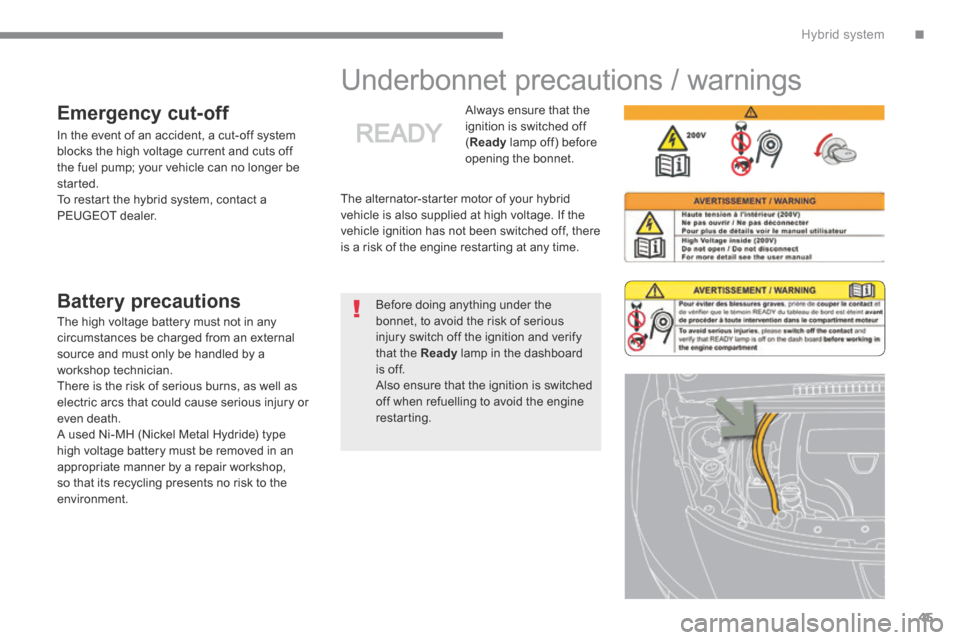
.Hybrid system45
Underbonnet precautions / warnings
The alternator-starter motor of your hybrid vehicle is also supplied at high voltage. If the vehicle ignition has not been switched off, there is a risk of the engine restarting at any time.
Always ensure that the ignition is switched off ( Ready lamp off) before opening the bonnet.
The high voltage battery must not in any circumstances be charged from an external source and must only be handled by a workshop technician. There is the risk of serious burns, as well as electric arcs that could cause serious injury or even death. A used Ni-MH (Nickel Metal Hydride) type high voltage battery must be removed in an appropriate manner by a repair workshop, so that its recycling presents no risk to the environment.
Emergency cut-off
Battery precautions
In the event of an accident, a cut-off system blocks the high voltage current and cuts off the fuel pump; your vehicle can no longer be started. To restart the hybrid system, contact a PEUGEOT dealer.
Before doing anything under the bonnet, to avoid the risk of serious injury switch off the ignition and verify that the Ready lamp in the dashboard is off. Also ensure that the ignition is switched off when refuelling to avoid the engine restarting.
Page 60 of 378
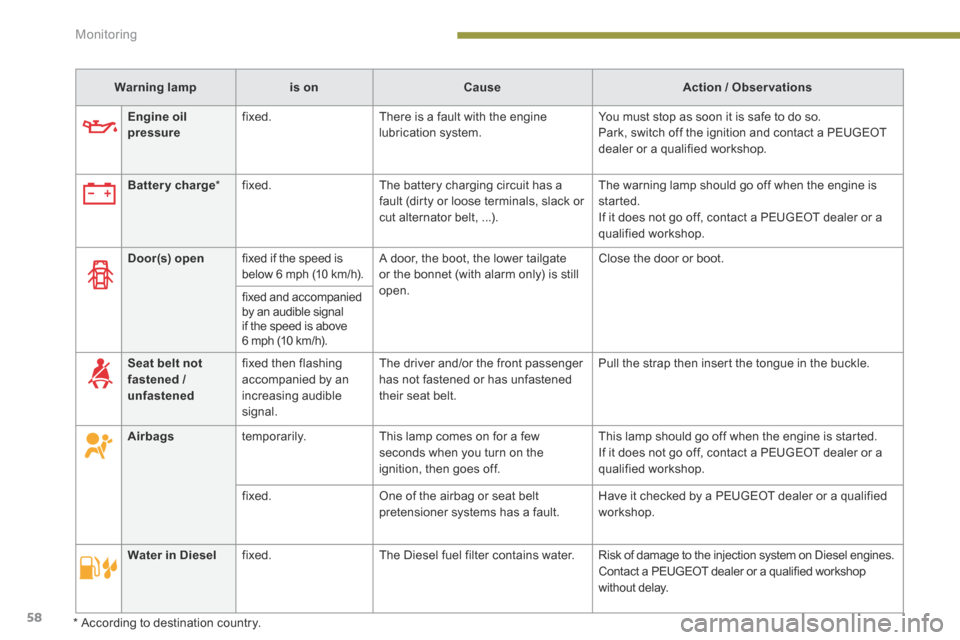
Monitoring
58
Warning lampis onCauseAction / Observations
Door(s) open fixed if the speed is below 6 mph (10 km/h). A door, the boot, the lower tailgate or the bonnet (with alarm only) is still open.
Close the door or boot.
fixed and accompanied by an audible signal if the speed is above 6 mph (10 km/h).
Seat belt not fastened / unfastened
fixed then flashing accompanied by an increasing audible signal.
The driver and/or the front passenger has not fastened or has unfastened their seat belt.
Pull the strap then insert the tongue in the buckle.
Airbags temporarily. This lamp comes on for a few seconds when you turn on the ignition, then goes off.
This lamp should go off when the engine is started. If it does not go off, contact a PEUGEOT dealer or a qualified workshop.
fixed. One of the airbag or seat belt pretensioner systems has a fault. Have it checked by a PEUGEOT dealer or a qualified workshop.
Water in Diesel fixed. The Diesel fuel filter contains water. Risk of damage to the injection system on Diesel engines. Contact a PEUGEOT dealer or a qualified workshop without delay.
Engine oil pressure fixed. There is a fault with the engine lubrication system. You must stop as soon it is safe to do so. Park, switch off the ignition and contact a PEUGEOT dealer or a qualified workshop.
Battery charge * fixed. The battery charging circuit has a fault (dirty or loose terminals, slack or cut alternator belt, ...).
The warning lamp should go off when the engine is started. If it does not go off, contact a PEUGEOT dealer or a
qualified workshop.
* According to destination country.